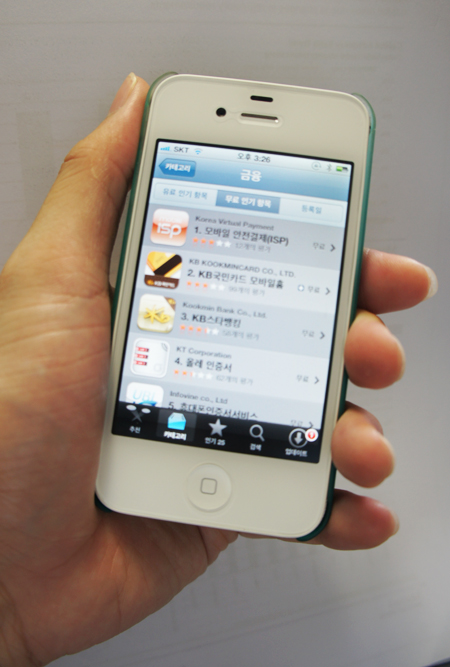
Mobile banking makes big jump

It was in the winter of 2009 when struggling wireless carrier KT brought Apple’s iPhone to these shores. And just like that the Korean finance industry entered a new era of portable banking, a significant transition that is irrevocably reshaping the personal finance experience.
While the explosion of mobile Internet devices like smartphones and tablet computers has been dramatically altering the way people interact, live and work, some of the most striking changes have been happening in financial services as tellers, cashiers and bookkeepers are increasingly replaced by small icons on touch screens.
For banks, credit card companies and other finance service providers, theses are times of both opportunity and challenge. They have yet to find the solutions to extend their full range of customer services to handsets and their lack of creativity in software technology and services has mobile users stuck with boring and carbon-copy applications.
Still, the age of mobile finance couldn’t have come earlier for Koreans, who had been growing increasingly frustrated with the country’s clunky Internet banking experience on personal computers bogged down by outdated technology and the Microsoft monoculture in computer operating systems and Web browsers.
“Smartphones are the new center of competition, as the handsets are now capable of handling a wider variety of services, including deposits, transactions and tax payments. We need to find a way to differentiate ourselves because this market will be lucrative,’’ said an official from KB Kookmin Bank.
Figures provided by financial regulators and banks suggest that the number of Koreans using smartphones for banking functions such as managing deposits and wiring money will surpass 20 million during the third quarter of the year.
The Bank of Korea (BOK) had measured the users of smartphone banking services at 13.66 million by the end of March, up nearly 32 percent from the end of last year. Recent data from the country’s largest commercial banks ― KB Kookmin, Woori, Hana, Industrial Bank of Korea (IBK), Korea Exchange Bank (KEB) and Nonghyup ― show a combined 15.96 million smartphone customers. The pace of growth suggests that the symbolic 20 million mark will be breached sometime during the July-September period.
The value of transactions from smartphones averaged 688.8 billion won (about $602 million) a day during the first quarter, the BOK said, up nearly 26 percent from the preceding quarter. With the market for smartphone banking services expanding quickly, banks are competing fiercely to offer higher interest rates on deposits and lower fees on transactions.
In comparison, the daily transactions through Internet banking services on personal computers were measured at around 33.2 trillion won in the three months through March, which represented just a 0.5 percent decline from the previous quarter.
Korea’s outdated regulations on online banking and electronic commerce have been a source of frustration for PC users. For most of the past decade, existing local regulations had required all encrypted online communications to be based on electronic signatures enabled through public-key infrastructures. And since the fall of Netscape in the early 2000s, Microsoft’s Active-X technology, used on its Internet Explorer (IE) Web browsers, remains the only plug-in tool used to download public-key certificates onto computers.
This prevented users of non-Microsoft browsers such as Firefox and Chrome from using banking services and purchasing products online. And computer security experts have also claimed that public-key certificates don’t add anything to security beyond a simple password gateway, which make them worse than useless as they create the illusion of safety where there is none.
Aside from the safety issues, usability is also a problem for Active-X plug-ins, as a three or four Active-X controls need to be installed to access online banking services of just one lender.
Now, the mobile Internet appears to be providing a new opportunity for companies to get online banking right.
KB Kookmin, which boasts more than 4 million smartphone customers, says it plans to differentiate itself by developing mobile services tailored to people in their 20s and 30s. Shinhan, which has 3 million smartphone customers, is providing a variety of deposit accounts that offer higher interest rates than those offered at teller windows. <The Korea Times/Kim Tong-hyung>


